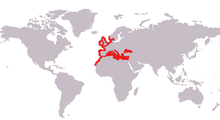European bass
| European bass | |
|---|---|
 |
|
| Scientific classification | |
| Kingdom: | Animalia |
| Phylum: | Chordata |
| Class: | Actinopterygii |
| Order: | Perciformes |
| Family: | Moronidae |
| Genus: | Dicentrarchus |
| Species: | D. labrax |
| Binomial name | |
|
Dicentrarchus labrax (Linnaeus, 1758) |
|
 |
|
| Synonyms | |
|
click to expand
|
|
The European bass (Dicentrarchus labrax) is a primarily ocean-going fish native to the waters off of Europe's western and southern and Africa's northern coasts, though it can also be found in shallow coastal waters and river mouths during the summer months. It is one of only six species in its family, Moronidae, collectively called the temperate basses. It is both fished and raised commercially, and is considered to be the most important fish currently cultured in the Mediterranean. It is marketed under a variety of names, including "sea dace," "seabass," and "Mediterranean seabass," among others. European bass can reach sizes of up to 1 m (3.3 ft) in length and 12 kg (26 lb) in weight, though the most common size is only about half of that at 0.5 m (1.6 ft). Individuals are silvery grey in color and sometimes a dark-bluish color on the back.
Juveniles form schools and feed on invertebrates, while adults are less social and prefer to consume other fish. They are generally found in the littoral zone near the banks of rivers, lagoons, and estuaries during the summer, and migrate offshore during the winter. Despite being a sought-after gamefish, it is listed as Least Concern by the International Union for the Conservation of Nature because it is widespread and there are no known major threats.
The European bass was first described in 1758 by Swedish zoologist Carl Linnaeus in his work Systema Naturae. He named it Perca labrax. In the century and a half following, it was classified under a variety of new synonyms, with Dicentrarchus labrax winning out as the accepted name in 1987. Its generic name, Dicentrarchus, derives Greek from the presence of two anal spines, "di" meaning two, "kentron" meaning sting, and "archos" meaning anus. The European bass is sold under dozens of common names in various languages. In the British Isles it is known as the "European bass," "European seabass," "common bass," "capemouth," "king of the mullets," "sea bass," "sea dace," "sea perch," "white mullet," "white salmon," or simply "bass."
...
Wikipedia

